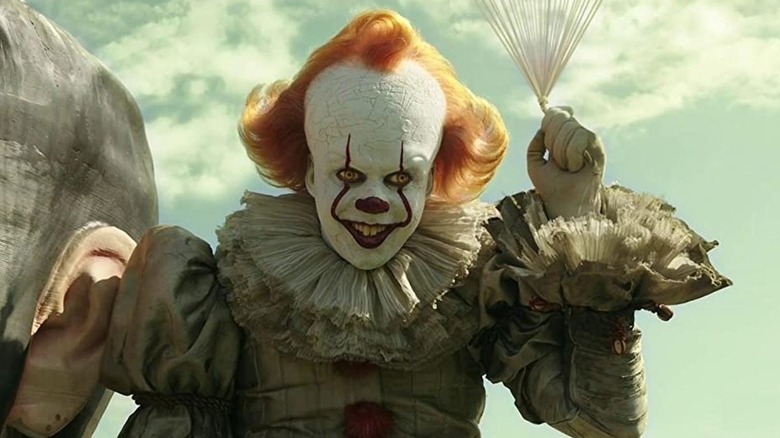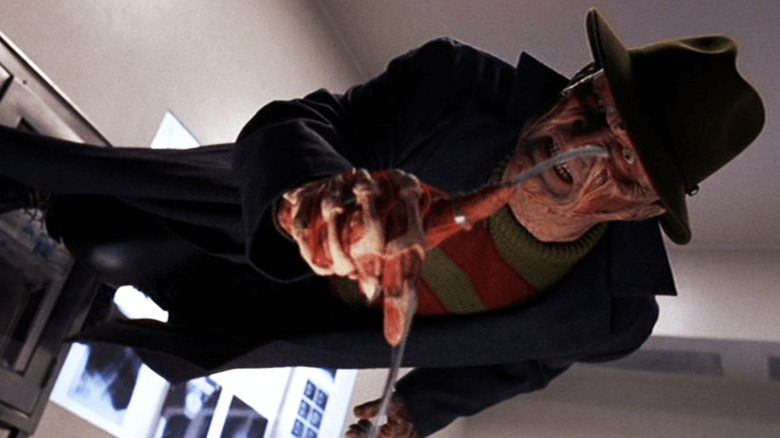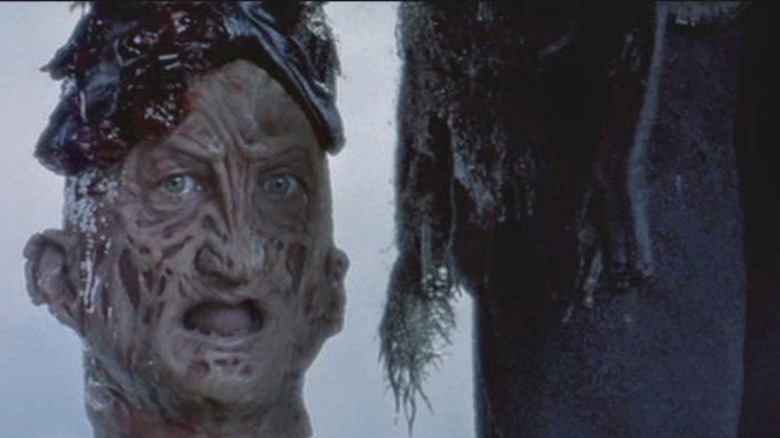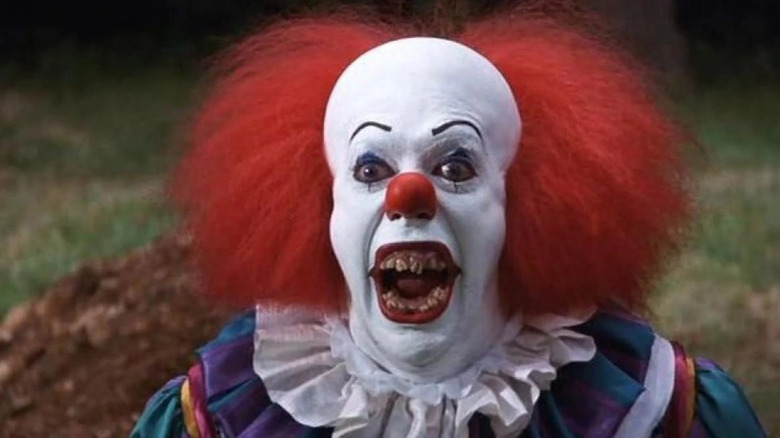/Film Showdown: Pennywise Vs. Freddy Krueger
Welcome back to /Film Showdown, wherein we pit a pair of genre giants against each other in a hypothetical Thunderdome to see who would triumph. So far we've seen Leatherface go up against the Priest of the "Hellraiser" films, Obi-Wan Kenobi face-off against Spock, and Magneto vs. Agent Smith. Today, /Film enters darker territory to speculate on a brawl between two mean distillations of evil. One is the creation of fiction maestro Stephen King, the other a creation of horror master Wes Craven. It's time to get ready to rumble with Pennywise the Dancing Clown of King's "It" and Freddy Krueger of Craven's "A Nightmare on Elm Street." Be excited, be passionate, be anything but afraid — because that's exactly what these two scoundrels want.
The shape-shifting creature of "It" takes on an array of forms; it can take on the likeness of spiders, lepers, possibly crossover bad guys from other King tales, and a Universal monster or two – each child gets a custom-made night terror tailored to the specific boogeyman that lurks under their bed. The reason is simple: fear and dread are the herbs and spices that turn a child from a Hungry Man dinner into a Michelin-starred meal. It's most recognizable form is that of Pennywise the Dancing Clown, who embodies pure, unfiltered evil, sustaining itself on the sweet ambrosia of children's souls.
So what better match-up in the war for kiddie fodder than Elm Street's original nightmare, Freddy Krueger? The Bastard Son of 100 Maniacs was borne of violence and spends his time as an agent of vengeance, forever punishing the progeny of the Elm Street parents who burned him alive after the child-killer escaped justice. In a battle royale between the villains, who would emerge the victor?
How it could happen
First off, both of these brutes are regional. With each terrorizing specific fictional towns, one might make the mistake of thinking that a scuffle could never come to fruition in the first place. But that's no fun!
Pennywise theoretically could leave Derry whenever It pleases, but throughout the franchise, It stays put in Derry. As for Freddy Krueger, he's found a few ways to leave the sleepy town of Springwood, whether it be visiting Camp Crystal Lake in "Freddy vs. Jason" or more notably, in "Freddy's Dead: The Final Nightmare" where he's absorbed so many victims' souls that he became powerful enough to transcend the limits of dreams and reality and uses his daughter, Dr. Maggie Burroughs, as a vehicle to shatter the bounds of Springwood. For the sake of argument, let's say that Maggie didn't actually blow dear ol' dad to smithereens and instead, Freddy has been slashing teens across the country, when he learns about the highly-publicized mass disappearances of children in Derry, Maine.
It's the perfect cover: Freddy could make his way to Derry and continue killing kids with reckless abandon and likely go unnoticed, as unexplainable deaths in Derry are as prominent as dandelions in fields of grass. Freddy arrives and finds a great new home in Derry, as the city is a hotbed of fear, secrecy, and children claiming to have seen horrific visions. Honestly, Freddy could clean house, especially with Pennywise in hibernation for 27 years. Eventually, however, the crown prince must awaken, and with Freddy already hacking the Derry children to bits, he's just made it a hell of a lot harder for Pennywise to track down It's next meal.
Hold on to your red balloons and striped sweaters, because it's about to be a showdown of child-soul snatching slashers.
Where it could happen
Derry is Stephen King's avatar of a typical New England town, and typical of King, the town holds more than a few dark secrets. If some Elm Street offspring were to make the grave mistake of wandering towards 29 Neibolt Street, it would be a real "out of the frying pan, into the fire" situation; someone should warn them not to look under the porch. The Standpipe, a Derry water tower that served as the setting for several child disappearances and drownings, was destroyed by the end of King's book, but beep beep, Georgie, not so fast — even the site has a nasty aura to it (King's 2001 novel "Dreamcatcher" sees a visit to the site's memorial, tagged with graffiti proclaiming, "PENNYWISE LIVES").
There are plenty of hotspots for combat, but the main arena would likely be one of the still-standing spots where the killer clown from outer space likes to operate: the Derry sewers. Freddy Krueger would surely be right at home in the dank, damp tunnels underneath Derry, since he often brings his sleeping teen victims into not only the dream world, but to the very boiler room where he was burned alive. Think of it as a no-holds-barred underground cage match, where Pennywise can sink his yellow chompers into Freddy's neck as easily as Freddy can lop off the clown's white-gloved hand.
Time to float
At first glance, things seem evenly matched. Both monsters can bend the rules of reality at will for their respective targets, turning a classroom nap into a trip to the boiler room or conjuring the scents of the circus to lure a child into chomping range. Each runs on tasty, tasty fear and/or children's myth-making in order to thrive, and both have been defeated by the unafraid (at least, until the sequel). But one has gotten their butt handed to them too many times to ignore. While it takes something as powerful and communal as the ancient Ritual of Chüd to conquer Pennywise, Freddy has racked up an embarrassing nine feature films' worth of losses. He's been decapitated, shoved in an oven, and in "A Nightmare on Elm Street 4: The Dream Master," he merely looks into a mirror and comes undone, clearly the easier of the two killers to overthrow.
The kill count makes the fight even more lop-sided: across the film franchise and generously including deaths from his "Freddy's Nightmares" TV series, the wisecracking slasher pulls a body count of 62 victims. Pennywise is harder to track because, as King's timeline shows, it is billions of years old (that's a long record of soul-eating). The documented numbers are devastating: the Kitchener Ironworks explosion of 1908 alone (set by Pennywise) was responsible for the deaths of 102 people, 88 of them children. That's just a taste — King's novel credits the deaths of an entire town of settlers to the entity, over 300 of them. Not only is Pennywise the longer-established of the two, but it's far more effective at its' mission. Freddy can't quip his way out of this one — Pennywise is the badder of the baddies, and Krueger is toast.
Final thoughts
As a soul-eating dream demon, Freddy isn't going to let a pesky death cause him to stop anytime soon, so after he's licked his wounds and probably the telephone of an unsuspecting victim, he'll be back. Now that he knows what Pennywise is capable of enacting if he gets in his way, there's a good chance that Freddy will start to follow a similar feeding pattern as Pennywise, terrorizing Derry during the metamorphing terror clown's 27 year off-season, returning home to Elm Street just when the residents of Springwood think they're safe, and keeping everyone's least favorite red balloon salesman out of his melted hair.
As for the funnyman, It's still got a surprise or two up its ruffled sleeve. The 27-year hibernation is like the pirate's code: it's more of a guideline than a hard rule. Pennywise can emerge from its slumber in the ballpark window of three decades, so Freddy had better tread lightly, lest he get caught unawares (and in the deadlights) on the clown's turf. Like anyone waking up from a nap, Pennywise is unlikely to be in a chipper mood, leaving the Springwood slayer at the mercy of an even more furious-than-usual Pennywise. No matter how sharp those finger-blades are, Freddy will float, too.




